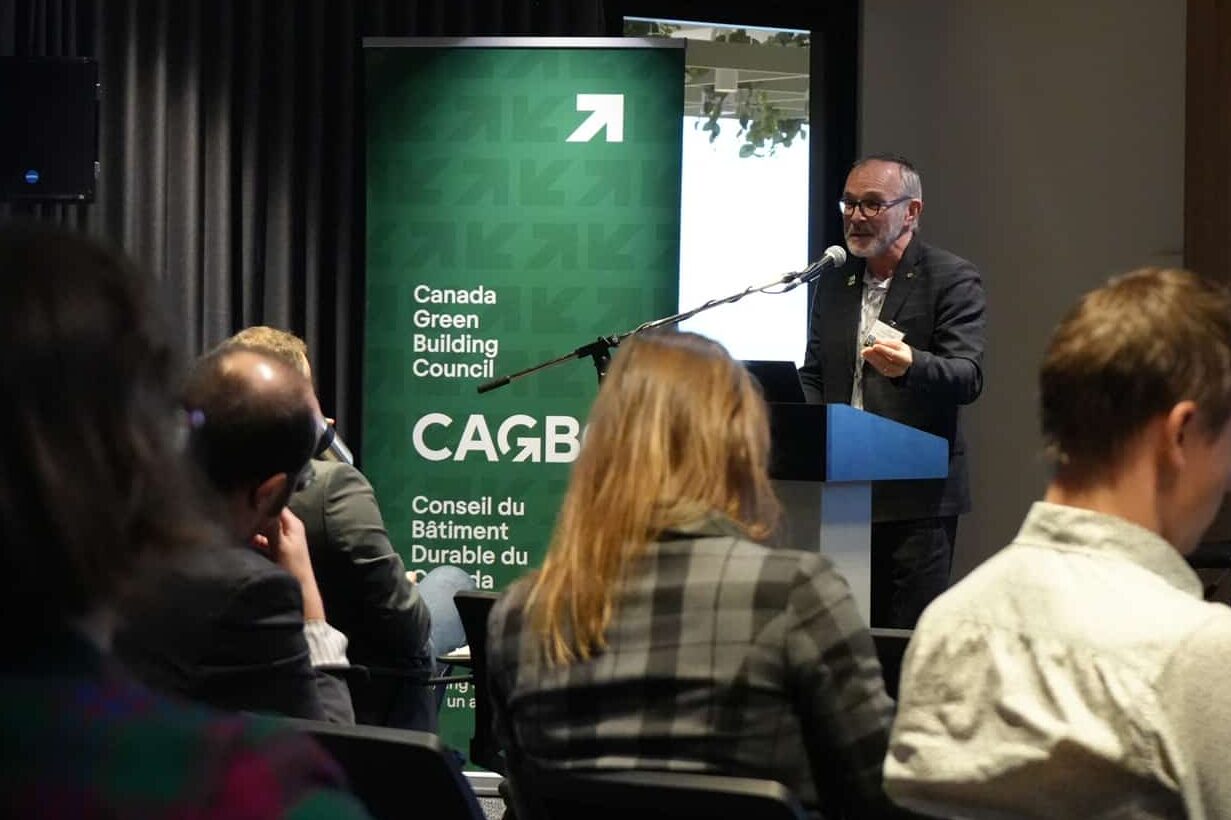LEED v5, a new era for sustainable buildings in Quebec
CAGBC staff on November 14, 2025
- Rating System/Standard
- LEED
- LEED v5
- Theme
- Certification updates
The Canada Green Building Council (CAGBC) recently organized a LEED v5 Summit in Montréal in partnership with Bâtiment durable Québec (BDQ). This sold-out event brought industry leaders together to explore how the new version of the world’s most widely used green building rating system is redefining high-performance, low-carbon buildings in Quebec and beyond.
The exclusive half-day event featured three panels exploring LEED® v5,highlighting key updates to the Building Design and Construction (BD+C) and Operations & Maintenance (O+M) rating systems — and their impact on current projects, assets, and long-term planning. Panelists Guillaume Martel, Partner and Architect at Provencher_Roy, Hugo Lafrance, Associate and Director of Sustainable Strategies at lemay, and Joël Courchesne, Architect at the City of Montréal, were joined by CAGBC’s Senior Vice President of Green Building Programs & Innovation, Mark Hutchinson as they presented and moderated discussions.
A comprehensive framework for evolving goals

Over the years, the urgency of climate change has not diminished, and neither has LEED’s relevance. LEED v5 represents the most ambitious update in the program’s history. It was shaped through extensive stakeholder consultation, responding directly to the industry’s call for greater flexibility, life cycle decarbonization strategies, resilience planning, and stronger data platforms for performance management.
This latest version is built around three core imperatives: decarbonization, quality of life, and ecological conservation and restoration. Together, these priorities position LEED v5 as a powerful tool for aligning Quebec’s building industry with its climate and sustainability goals. “LEED v5 places greater emphasis on carbon, reflecting some of the key areas addressed by the Zero Carbon Building Standards” said Hutchinson, during his opening comments. “It supports decarbonization in a holistic, and comprehensive way, allowing decision-makers to see the impact of their investments.”

LEED’s evolution has always mirrored the shifting priorities of the market it serves. LEED v5 moves from a checklist-based approach to a performance-driven framework that guides design, construction, and operations throughout a building’s entire life cycle. Introducing a five-year development cycle will ensure this version and future ones remain adaptive to emerging technologies and policy shifts, while improving predictability for project teams. It also redefines what leadership means in sustainable building, placing decarbonization, resilience, and quality of life at the core of certification to reflect market expectations and growing demand for climate-ready buildings. “LEED v5 takes into account the different priorities of stakeholders to make upstream decisions and improve project resilience,” said LEED Fellow Hugo Lafrance. “It is a powerful tool that meets the needs of project teams at different stages. I am delighted to see how the credits have been restructured for greater impact and synergy.”
Resilient through versatility
For 25 years, LEED certification has provided a trusted framework for designing, constructing, and operating buildings that are healthy, efficient, and profitable. Supported by a robust community of professionals and organizations, LEED has evolved to meet the continuously changing requirements of buildings and practice. Across markets, LEED-certified buildings have consistently demonstrated superior performance, offering lower operating costs, enhanced occupant well-being, and stronger market value. They also give investors, owners, and tenants greater confidence in sustainability outcomes backed by measurable data and third-party verification. “LEED v5 contributes to standardizing green building practice by rewarding responsible design, particularly when it comes to materials selection,” said LEED Fellow Martel. “It allows project teams to make high-impact choices that improve emissions, improve health outcomes, and advance sustainable practices across the building industry.
While LEED v5 builds on previous versions, it introduces key innovations that make it more impactful and adaptable such as a carbon-first structure that integrates decarbonization across credits, resilience principles embedded throughout, and project-specific priority pathways that give teams more freedom to choose solutions that are more suited to their projects’ specificities and local context.
As the discussion turned to planning, panelists unpacked how LEED v5’s flexible structure can be applied to support Quebec’s plans to decarbonize at scale. Applicable to every building type and scale, climate and building type, the system credit structure has gotten even more flexible with this new version, allowing project teams to set priorities based on local risks, regional energy profiles, and community needs, ensuring that sustainability strategies remain both relevant and resilient over time.
Quebec’s green building standard of choice
In the case of Quebec, a clean electricity grid offers a unique opportunity for projects to focus on embodied carbon and energy optimization, two areas the new version expands on. The system requires all projects to conduct operational carbon projections to 2050, empowering teams to chart a clear decarbonization strategy. It gives Quebec’s developers, owners, and municipalities the tools to achieve higher performance, lower emissions, and stronger returns—both environmental and economic.
In Montréal, we already have a good understanding of the climate hazards we should be concerned about thanks to our vulnerability map,” said Courchesne. The new prerequisites introduced by LEED v5 help project teams better identify and assess climate risks. In the long term, this will help improve the resilience of buildings and infrastructure in general, particularly the electrical grid.”
Quebec’s green building community has long been at the forefront of sustainable innovation in Canada, championing LEED adoption especially in the residential sector. Through this comprehensive overview, attendees are now primed to leverage greater opportunities from LEED v5 and continue positioning Quebec on the map as a leader in sustainable design and construction.
CAGBC would like to thank all panelists for their involvement summit sponsors Arup and Soprema for their support, and delegates for their engagement.
